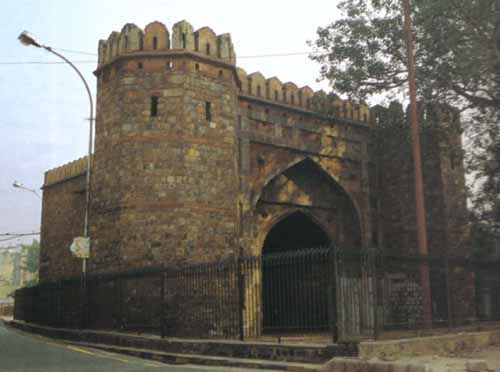Delhi Gate

Information on Delhi Gate (New Delhi) - History & Architecture
Traditionally, Delhi was regarded as the city of 'seven castles' characterised by 52 gates. However, at present only 13 gates remains and can be recognised by travellers. One of the 13 gates is Delhi gate. It is a one of the gateways of Shahjahanabad, the seventh city of Delhi. The city was created during 17th century and was established like huge fort enclosed by robust walls with 14 gates. At the base of the city was Red Fort which was quite challenging for enemy to enter and was created under the authority of Mughal emperor. The Delhi gate was the southern gateway of Red Fort. Presently, Delhi Gate links New Delhi with Old Delhi. It is situated at the endpoint of Netaji Subhash Chandra Road of Delhi.
Delhi Gate Architecture
The architecture of Delhi Gate is quite simple and was developed through locally accessible stones. The name of the gate was based on the road which led to the previous cities of Delhi. The road was popularly called as 'Thandi Sarak' or 'cool road', because the way was lined with numerous tress which provided sufficient shadow for keeping the blazing sunlight away. Developed through red sandstone, Delhi Gate is still regarded as an impressive gateway of India. Although the gate is not really able to reflect the original splendour, it has significant architectural importance. Near the entrance of the gate, there are two splendid statues of elephants. One stimulating aspect of Delhi Gate is that it looks like old wooden locking system, which is not in use at present times.
Delhi Gate History
Delhi gate was created by Shahjahan in the year 1638 as a part of development of strong wall for the Red Fort which bordered the city Shahajahanabad. Shahajahanabad had 14 entry gates which lead towards the city. In addition, there was also 16 exit gates which are also termed as 'windows'. Furthermore, various mainstays were also established in Shahajahanabad during British rule for making the Red Fort more protected. The gates of Shahajahanabad were developed for people along with the royal families to gain access to the city. Presently, only five gates remain in Shahajahanabad city namely Kashmiri Gate on the northern side, Turkman Gate on the southern side, Nigambodh Gate on the north eastern side and Delhi Gate on south eastern side. Each of the gate exhibit the grandeur of the city. The gates possess square plan with high curved openings. The Delhi Gate is one of the important gates of Shahajahanabad and a key entrance towards Red Fort. Furthermore, one significant historical aspect of the gate is that the emperor Shahjahan used this gate in order to go to the Jama Masjid.
Delhi Gate Tourism Significance
The gates of Shahajahanabad are regarded as significant destination for travellers. The Delhi Gate also has certain historical significance with rich story of Mughal and British emperor that is even today the major highlight. The gate has certain architectural resemblance with other gates. The road that pass through Delhi Gate, lead towards Kashmiri Gate, the other important gate of Shahajahanabad city. Delhi Gate is regarded as the key specimen of dynastic rulers of that era and thus its importance cannot be neglected and so it is regarded as a popular heritage sites and an important place for tourists to visit. While in Delhi, just pay a visit to noteworthy its historical importance or the era gone by.
- Andaman Nicobar Monuments
- Andhra Pradesh Monuments
- Assam Monuments
- Bihar Monuments
- Chhattisgarh Monuments
- New Delhi Monuments
- Goa Monuments
- Gujarat Monuments
- Haryana Monuments
- Himachal Pradesh Monuments
- Jammu and Kashmir Monuments
- Karnataka Monuments
- Kerala Monuments
- Madhya Pradesh Monuments
- Maharashtra Monuments
- Odisha Monuments
- Punjab Monuments
- Rajasthan Monuments
- Tamil Nadu Monuments
- Telangana Monuments
- Uttar Pradesh Monuments
- West Bengal Monuments